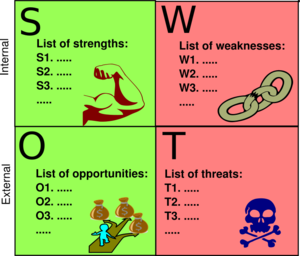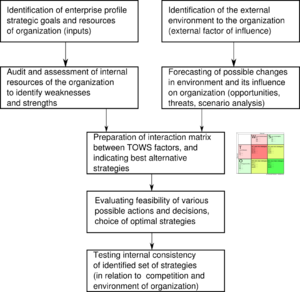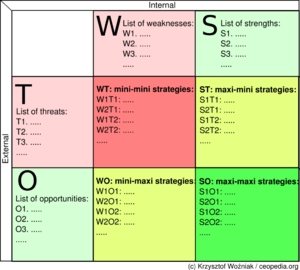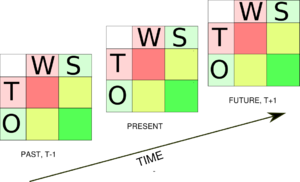TOWS analysis
| TOWS analysis |
|---|
| See also |
TOWS analysis is a method of strategic analysis used to study the environment of the organization and company situation analysis. TOWS concept is closely related to the SWOT analysis. According to H. Weihrich: Threats, Opportunities (in the environment), Weaknesses, Strengths (of the organization) should be analysed in this order, as a proper problem-solving sequence in the process of strategy formulation. He also notes, that "...many writers ...suggest that a firm uses its strengths to take advantage of opportunities, but they ignore other important relationships, such as the challenge of overcoming weaknesses to exploit opportunities".
It is based on a simple classification scheme: all of the factors influencing the current and future position of the organization is divided into:
- external and internal to the organization,
- having negative and positive impact on the organization.
TOWS analysis is method of the strategic analysis, involving systematic and comprehensive assessment of external and internal factors that determine current competitive position and growth potential of the company. TOWS analysis is closely related to more popular SWOT analysis but according to Michael Watkins order of word in acronym SWOT implies wrong order of doing process of serious strategic analysis. Starting from analysis of Strengths is wrong, because managers should first identify all threats from environment in order to do following steps of planning and preparation to protect against these threats.
Analytical categories in TOWS analysis
The combination of the above-mentioned groups of factors emerge four specific analytical categories, filling the fields TOWS matrix:
Strengths
Strengths are the internal factors, positive characteristics of the organization, which distinguish it in the environment and from the competition, they are often called: key success factors. They enable adaptation to changing conditions of the market environment.
Analysis of the strengths of the organization should include at least the following areas:
- area of knowledge and human resources,
- area of logistics, production, technology, research and development,
- area of sales and customer service,
- area of finance and capacity development,
- area of management systems and business processes.
Examples of strengths, which can serve as a template to help prepare a comprehensive TOWS analysis is presented in article: Examples of strengths.
Weaknesses
- Weaknesses (internal negative factors, or challenges) - mostly consequences of resource constraints and insufficient skills. Each organization has limits to its fitness, but the rapid and objective diagnosis and definition can reduce their negative impact. Areas of organizational analysis is the same, as above mentioned.
Examples of weaknesses, which can serve as a template to help prepare a comprehensive TOWS analysis is presented in article: Examples of weaknesses.
Opportunities
- Opportunities (external positive) - phenomena and trends in the environment that if used appropriately could stimulate the development of company and weaken the threat. An opportunity within the meaning of strategic management, is always something outside the organization, something on what the leadership does not have direct influence, something that can change in an unexpected way without relations to the company's activities.
The most distinguished sources of opportunities in the environment of the company, are:
- political factors,
- economical factors,
- social and cultural factors,
- technological factors affecting business,
- legal factors,
- environmental factors,
- ethical factors.
Examples of opportunities which can serve as a template to help prepare a comprehensive TOWS analysis is presented in article: Examples of opportunities.
Threats
- Threats (external negative) - all the external factors, which is perceived as barriers to the development of the company, inconveniences causing additional costs of the action. A threat according to strategic management, is always something outside of the organization, something on what managers does not have any influence, something that can change in an unexpected way without relations to their decisions and actions.
Examples of threats, which can serve as a template to help prepare a comprehensive TOWS analysis is presented in article: Examples of threats.
Comparing opportunities and threats with strengths and weaknesses of the company allows to define its strategic position, and can also be a source of innovation, and ideas of breakthrough products or services.
Steps of TOWS analysis
Basic steps of TOWS analysis procedure are as follows (fig. 1.):
- Identification of enterprise profile (industry, customers, needs, trends), strategic goals (mission and vision of managers) and resources of organization (financial, material, employee, knowledge and information),
- Identification of the external environment to the organization (external factor influencing its strategy, political, legal, economics, technology, social and cultural, ethical),
- Forecasting possible changes of environment and its influence on organization (scenario analysis, trends, perspectives),
- Audit and assessment of internal resources of the organization to identify weaknesses and strengths,
- Preparation of interaction matrix between TOWS factors, and indicating best alternative strategies,
- Evaluation of alternative strategies, evaluating feasibility of various possible actions, choice of best strategies,
- Testing internal consistency of identified portfolio of strategies (in relation to competition and environment),
- Preparation of contingency plans in case of failure of the undertaken actions.
Usually general guidelines and recommendations for management derived from using TOWS analysis are simple but difficult in execution:
- company should avoid threats,
- company should exploit opportunities,
- company should strengthen its weaknesses,
- company should base important activities on its strengths.
TOWS matrix of strategic alternatives
There are four basic strategies depending on the prevalence of the analysed group of factors (positive or negative) in the environment and within the company:
- SO situation - maxi-maxi strategy. This situation applies to the company for which dominates strengths in the environment and opportunities within. This situation corresponds to the maxi-maxi strategy: strong expansion and diversified development.
- WO situation - mini-maxi strategy. In this situation company has more vulnerabilities - weaknesses, but its environment gives more opportunities. The strategy should include the use of these opportunities while reducing or correcting weaknesses within the organization.
- ST situation - maxi-mini strategy. The source of development difficulties for the company are unfavourable external conditions (prevalence of threats). The company may use large internal strengths in attempt to overcome threats from environment.
- WT situation - mini-mini strategy. The company in this case is devoid of any development opportunities. It operates in hostile environments, and its potential for change is small. It does not have significant strengths, which could withstand threats. Mini-mini strategy boils down to a pessimistic version of the liquidation or in optimistic situation - to strive for survival, or merger with another organization.
Final results of TOWS analysis is presented graphically on Fig. 2.
The colour red in the picture indicates the strategies to be adopted for the negative combination of threats and weaknesses. The green colour indicates the strategies of strongly positive character from the point of view of the company.
From those basic strategic alternatives, managers should derive more concrete strategies (or its combination) such as:
- specialization or concentration,
- forward or backward integration,
- diversification,
- product innovation,
- internationalization,
- liquidation (termination of an unprofitable product line).
During strategy formulation, managers must give significant attention to consistency between decisions made on every steps of strategic analysis and planning process. They should also prepare contingency plans in case of failure or unpredictable change in external environment.
Time dimension in TOWS analysis
H. Weinrich noted, that due to dynamic character of external and internal environments, some or all factors change in time. Managers should then prepare at least 3 TOWS matrices (fig. 3), starting analysis in past (year or two before present moment), continuing with an analysis of the present situation, and then focus on analysis of the future external and internal situation.
See also:
Advantages of TOWS analysis
- TOWS analysis is an effective way to identify the external and internal factors of an organization. It helps to analyze the environment and the company situation by breaking it down into four parts: Threats, Opportunities, Weaknesses, and Strengths.
- TOWS analysis encourages creative thinking and helps to generate a variety of strategies to cope with the external environment.
- It can help to identify the potential opportunities and threats and how the organization can use its strengths to take advantage of them.
- TOWS analysis helps to identify the gaps between the organization's current performance and the desired level of performance.
- It helps to develop strategies that can be used to maximize the strengths of the organization and minimize the weaknesses.
- TOWS analysis can be used to identify and analyze potential strategic partners and alliances.
- Lastly, it helps to pinpoint potential areas for improvement and to develop plans to address them.
Limitations of TOWS analysis
- TOWS analysis does not provide any guidance on what strategies should be pursued. It is up to the company to decide which strategies to pursue based on the analysis of the environment.
- Another limitation is that it does not take into account external factors such as the macroeconomic environment, political and social context, or technological advancements that can affect a company’s operations.
- It also does not factor in the potential impact of any strategies that the company may pursue.
- It also does not consider the potential risks and rewards associated with a particular strategy.
- It also does not take into consideration the resources and capabilities of the company and how they may affect the success of a strategy.
- Finally, it does not consider the potential costs associated with implementing a particular strategy.
- PEST Analysis is a type of management analysis which focuses on the macro-environmental external factors that are likely to have an impact on the organization. It assesses the Political, Economic, Social, and Technological factors in the external environment that can affect the organization.
- STEEPLE Analysis is a tool used for environmental scanning and for analyzing the external environment of the organization. It stands for Social, Technological, Economic, Environmental, Political, Legal, and Ethical factors that can influence the organization’s performance and strategic decision making.
- Eco-SWOT Analysis is a tool used to analyze the external and internal environment of an organization. It stands for Ecological, Social, Weaknesses, Opportunities, Threats. This tool helps to identify and analyze the internal strengths and weaknesses of an organization, as well as the external opportunities and threats from the environment.
In summary, TOWS analysis is a method of strategic analysis used to study the environment of the organization and company situation analysis. Other related approaches for environmental scanning and for analyzing the external environment of the organization are PEST Analysis, STEEPLE Analysis, and Eco-SWOT Analysis, which all focus on different factors that can influence the organization’s performance and strategic decision making.
References
- Al Salmi, M. A. A., & Hasnan, N. B. (2015). SWOT and TOWS matrix e-Government analysis review on Sultanate of Oman. International Journal of Learning and Development, 5(4), 13-23.
- Knott, P. (2006). A typology of strategy tool applications. Management Decision, 44(8), 1090-1105.
- Ravanavar G.M., Charantimath P.M., (2012) Strategic Formulation Using TOWS Matrix - A Case Study, International Journal of Research and Development, vol. 1, iss. 1.
- Watkins M. (2007, March), From SWOT to TOWS: Answering a Reader’s Strategy Question, Harvard Business Review, March 27.
- Weihrich, H. (1982), The TOWS matrix: a tool for situational analysis, Long Range Planning, 15(2), 54-66.
- Weihrich, H. (1982). Strategic career management—A missing link in management by objectives. Human resource management, 21(2‐3), 58-66.
- Weihrich, H. (1993). Daimler-Benz's move towards the next century with the TOWS matrix. European Business Review, 93(1).
- Yu Hern Chang, Wu Kitty, (2010, Summer). Using a TOWS Matrix in the Achievability-Effectiveness Analysis for Scooter Commuters Interchange to Public Transportation in Kaohsiung, Transportation Journal (American Society of Transportation & Logistics Inc), Vol. 49 Issue 3, p. 39-47.
Author: Krzysztof Wozniak



